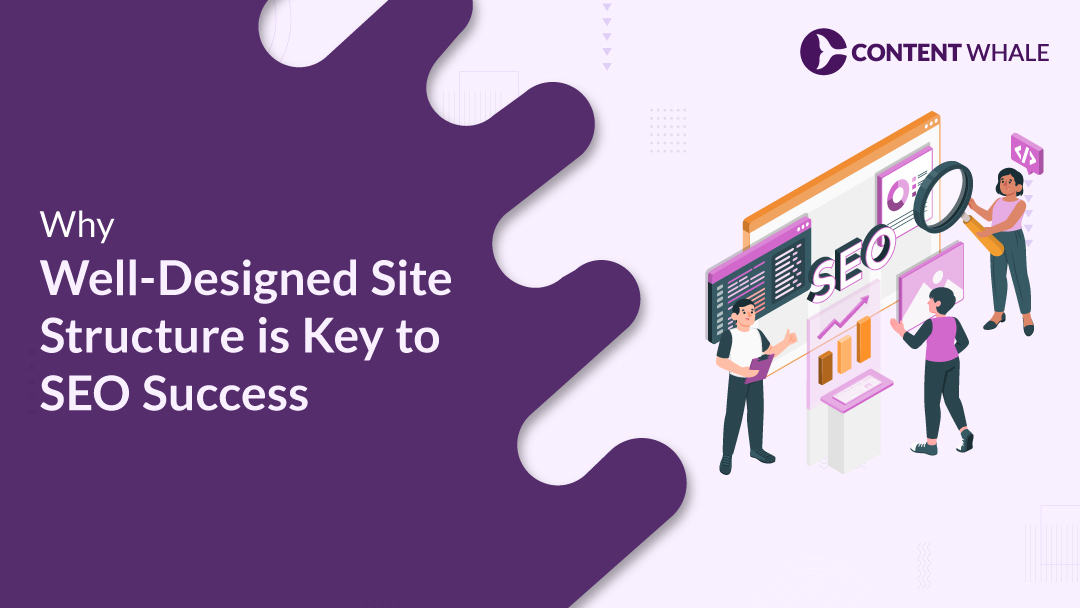A well-organized website is more than just visually appealing—it’s a key player in achieving strong search engine rankings. Website architecture refers to how pages on your site are structured and linked together, impacting everything from how easily users can find information to how efficiently search engines can crawl your content.
When discussing why website architecture is crucial for SEO, it’s essential to understand that this structure acts as the backbone of your online presence, influencing both user experience and SEO performance.
The purpose of this blog is to dive into the reasons why a well-thought-out SEO website structure is indispensable.
We’ll explore how it affects site crawlability, improves site navigation, and enhances internal linking—all of which contribute to better search engine rankings.
Whether you’re a seasoned webmaster or just starting, understanding the importance of site architecture optimization is essential for driving traffic and keeping visitors engaged.
Enhances Crawlability and Indexing
A well-structured site architecture is essential for ensuring that search engines can effectively crawl and index your website’s content.
Crawlability refers to how easily search engine bots can navigate your website and discover new or updated content.
A logical SEO website structure allows these bots to efficiently map out your site, ensuring that all important pages are indexed.
To optimize crawlability:
- Create an XML Sitemap: This acts as a guide for search engines, highlighting the most critical pages on your site.
- Implement a robots.txt File: Control which parts of your site should be crawled and which should be excluded, such as duplicate content or administrative pages.
- Maintain a Shallow Site Structure: Ensure users can reach any page within a few clicks, which not only enhances user experience but also improves the crawlability of your site.
By optimizing your website architecture for better crawlability, you enable search engines to navigate and index your content more efficiently. This process is crucial for improving your site’s visibility in search engine results.
Improves User Experience and Engagement

A well-designed website architecture goes beyond just technical structuring—it plays a crucial role in enhancing user experience (UX) and driving engagement. When users visit your site, their ability to quickly and intuitively navigate through your content significantly impacts their satisfaction and likelihood of returning.
Here’s how site structure influences user experience:
- Clear Navigation: A logical and straightforward site navigation ensures that users can easily find the information they’re looking for. This reduces frustration, lowers bounce rates, and keeps users on your site longer.
- Internal Linking: Effective internal linking helps guide users to relevant content, encouraging them to explore more pages. This not only improves engagement but also distributes link equity, enhancing overall content performance.
- Enhanced User Interaction: A user-friendly SEO website structure boosts time spent on your site—a key metric for search engines to assess content relevance and quality. A well-organized site makes your content more accessible, leading to a more enjoyable user experience.
By focusing on site architecture optimization, you’re creating a more engaging environment for your audience, which can lead to higher conversion rates, improved customer satisfaction, and a better return on investment (ROI) from your content marketing efforts. Prioritizing these elements ultimately strengthens user loyalty and encourages repeat visits.
Boosts Internal Linking Strategy
A well-executed internal linking strategy is a cornerstone of effective content marketing and SEO. Internal links connect one page of your website to another, guiding users through your content and helping search engines understand the structure of your site. The benefits of internal linking are numerous, both for user experience and for enhancing your site’s search engine visibility.
Key Benefits of Internal Linking:
- Improved Content Discoverability: Internal links make it easier for visitors to find relevant content on your site. By strategically placing links within your content, you can guide users to related topics, keeping them engaged longer and reducing bounce rates.
- Distribution of Link Equity: Internal links help distribute link equity (sometimes referred to as “link juice”) across your website. This can enhance the ranking potential of deeper pages, not just your homepage. When search engines crawl your site, they follow these internal links, understanding the importance and relevance of various pages based on how they are interconnected.
- Enhanced Keyword Relevance: When you link to other pages on your site, you can use anchor text that includes target keywords. This practice reinforces the relevance of the linked pages for those keywords, potentially boosting their visibility in search results.
- Content Performance Monitoring: By analyzing the performance of your internal links—using tools like Google Analytics—you can identify which links are most effective in driving traffic and engagement. This insight allows you to optimize your internal linking strategy continuously.
Best Practices for Internal Linking:
- Use Descriptive Anchor Text: Ensure that the anchor text you use is descriptive and relevant to the content of the linked page. This helps both users and search engines understand what to expect after clicking the link.
- Link to High-Value Pages: Focus on linking to pages that are valuable to your visitors, such as cornerstone content, product pages, or blog posts that provide in-depth insights. This can boost the authority of these pages and improve their rankings.
- Avoid Overlinking: While internal linking is beneficial, overloading a page with too many links can be counterproductive. It can dilute the link equity and overwhelm users, making it harder for them to navigate your site effectively.
By implementing a thoughtful internal linking strategy, you can significantly enhance your content performance, drive better engagement, and ultimately see a positive return on investment (ROI) from your content marketing efforts. Regularly reviewing and optimizing your internal links ensures that your site remains user-friendly and search engine-friendly, helping you achieve sustained growth in organic traffic and conversions.
Optimises URL Structure for SEO

A well-optimized URL structure is a vital part of improving SEO and enhancing user experience. URLs that are clear, concise, and well-structured not only help search engines understand the content on your page but also provide users with an immediate sense of what to expect.
Key Considerations for Optimizing URL Structure:
- Keep URLs Descriptive and Relevant: Ensure that your URLs clearly reflect the page content. Incorporating keywords into your URL is beneficial for both search engine visibility and user clarity. However, it’s essential to avoid keyword stuffing, as it can negatively impact your content performance.
- Use Hyphens to Separate Words: For better readability and SEO, use hyphens instead of underscores in URLs. Hyphens are recognized by search engines as word separators, making it easier for them to index the content correctly.
- Short and Simple URLs: Shorter URLs are easier to read, share, and remember. They are also less likely to be truncated in search results or social media platforms, ensuring that users see the full URL and its intent.
- Avoid Dynamic URLs: Whenever possible, use static URLs instead of dynamic ones that include parameters like “?” or “=”. Static URLs are more user-friendly and easier for search engines to crawl and index, which leads to better rankings and improved ROI from your content marketing efforts.
- Strategic Keyword Placement: Place important keywords closer to the beginning of the URL to maximize their impact. This approach is favored by both search engines and users, enhancing the relevancy and ranking potential of the page.
By adhering to these best practices for URL optimization, you can enhance your site’s SEO performance, improve user experience, and ultimately achieve better results in terms of key performance indicators (KPIs) and overall marketing analytics. A well-structured URL is a powerful tool in ensuring that your content achieves its full potential in search engine rankings and user engagement.
Facilitates Better Content Organisation
A well-organized content structure is crucial for both user experience and SEO effectiveness. Properly categorizing and tagging your content not only helps users easily navigate your site but also enables search engines to better understand and index your content, improving overall content performance.
Key Benefits of Effective Content Organisation:
- Enhanced User Experience: When content is logically structured, users can quickly find the information they are looking for. This reduces bounce rates and increases the time visitors spend on your site, which positively impacts your site’s ROI and other key performance indicators (KPIs).
- Improved Search Engine Visibility: A well-organized site helps search engines index your pages more efficiently. Proper use of headings, subheadings, and internal links creates a clear hierarchy, signaling the relevance of your content to search engines. This can lead to higher rankings in search results, directly benefiting your marketing analytics and overall SEO strategy.
- Efficient Content Updates: A logical content structure makes it easier to update and optimize existing content. As SEO trends evolve, you can quickly identify and refresh outdated content, ensuring that your site remains competitive and continues to perform well in search rankings.
Best Practices for Content Organisation
- Use Clear, Descriptive Categories: Organize your content into well-defined categories that reflect the main topics of your site. This helps users and search engines alike in understanding the focus areas of your content.
- Incorporate Relevant Tags: Tags can further classify content within categories, making it easier for users to find related articles. This also assists in creating effective internal links, which are vital for distributing link equity across your site.
- Regular Content Audits: Conducting regular audits of your content ensures that everything remains organized and relevant. This includes checking for broken links, updating outdated information, and ensuring that all content is correctly categorized and tagged.
By maintaining a well-organized content structure, you can significantly enhance the usability and search engine visibility of your site. This approach not only improves content performance but also maximizes the return on investment (ROI) from your content marketing efforts.
Conclusion

A well-planned website architecture is essential for effective SEO and user experience. By organizing your content into a logical, easy-to-navigate structure, you enhance your site’s content performance and make it easier for search engines to index your pages.
Key elements like a flat site structure, strategic internal linking, and optimized URL hierarchies are crucial for improving search visibility and user engagement. These efforts lead to better rankings and a stronger ROI on your content marketing initiatives.
Investing time in optimizing your website’s architecture not only boosts your SEO but also ensures a seamless experience for your users, ultimately driving long-term success.
FAQs
1. What is website architecture in SEO?
Website architecture refers to how the pages on your site are organized and interconnected. It plays a key role in SEO by influencing how search engines crawl and index your content. A well-structured website improves crawlability, enhances user experience, and ensures that important pages are easily accessible, which can positively impact your site’s search rankings.
2. How does site structure impact SEO?
A logical and intuitive site structure helps search engines understand the relationships between pages, allowing them to rank your content more effectively. It also enhances the user experience by making navigation easier, reducing bounce rates, and encouraging visitors to stay longer, which can improve overall site performance.
3. What are the best practices for internal linking?
Internal linking is crucial for distributing link equity and guiding users through your site. Best practices include using descriptive anchor text, linking to high-value pages, and regularly auditing links to ensure they are functional and relevant. Effective internal linking boosts both SEO and user engagement.
4. How do I create an SEO-friendly URL structure?
An SEO-friendly URL structure is short, descriptive, and reflects the site’s hierarchy. Use hyphens to separate words, include relevant keywords, and avoid unnecessary parameters. This helps both users and search engines understand your content better.
5. Why is user experience important in website architecture?
User experience is vital because it directly affects how visitors interact with your site. A well-organized architecture ensures that users can easily find what they need, which improves satisfaction, reduces bounce rates, and increases the likelihood of conversions. Good user experience also signals to search engines that your site is valuable, which can enhance your rankings.





